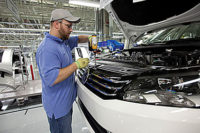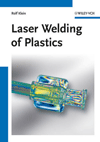Think of your house. How many people live there? Four? Six? What if there were three or five times that number? It would be pretty uncomfortable, wouldn’t it?
According to Jonathan G. Overly, a research associate at the Center for Clean Products and Clean Technologies at the University of Tennessee (Knoxville), that’s exactly the situation we all face as citizens of the world. "The vast majority of what we consume is not returned to the natural system," he says. "It’s put in the ground as solid waste or it’s burned.
"With that in mind, individuals and corporations need to think about what we are doing to this planet. We have to come up with more sustainable ways of doing business."
In fact, that’s just what many manufacturers around the world are beginning to do. Some have been forced to do it because of legislation. Others have been more proactive. Either way, a growing number of manufacturers are considering the environmental impact of their products. Manufacturers are using more recycled materials, and designing products to be reused and recycled. Manufacturers are evaluating the environmental effects of their products across their entire life cycles, from raw material production to use and obsolescence. Manufacturers are even changing their business models to be more green. Instead of selling, then forgetting, their products, some manufacturers have adopted a service business model: taking back old products, and either refurbishing them or using them as raw material for new products.
Tools for Environmental Design
A number of tools are available to help engineers evaluate the environmental impact of product designs.Among the simplest are checklists that ask basic environmental questions about a product:
- What types of plastic are used in the product? And how much?
- How much waste is generated by the manufacturing process?
- What packaging materials are used for shipping and retail display?
- Can any components be reused?
- Can any materials be recycled?
For example, a scorecard produced by the West Michigan Sustainable Business Forum (Grand Rapids) rates a product on 14 points of environmental concern, including resource depletion, worker health, manufacturing energy, durability and recyclability. For each point, the product is rated on a scale of 0 to 5. A 0 rating indicates "good environmental performance," a 5 rating indicates "very poor environmental performance." The scores for each point are then totaled to derive a benchmark figure. From there, manufacturing and design engineers can attack individual issues so as to achieve the lowest possible total score.
Checklists and scorecards are available from several academic, governmental and corporate sources in the United States, Canada and Europe, including the Minnesota Office of Environmental Assistance (St. Paul) and the Industrial Research Assistance Program of the National Research Council of Canada (Ottawa, Ontario).
A more complex tool is the Design for Environment (DFE) software from Boothroyd-Dewhurst Inc. (Wakefield, RI). The software simulates the disassembly of a product at the end of its life, and reveals the cost benefits and environmental impacts of a product design. This quantitative information can then be used to make informed trade-off decisions at the earliest design stages.
The DFE software can work together with Boothroyd-Dewhurst’s Design for Manufacture and Assembly (DFMA) software. The initial disassembly sequence can be automatically generated from DFMA assembly lists. The user can edit the initial assembly list to form groups of items that will not be taken apart at the end of the product’s life, regardless of whether the items will be recycled or discarded as a whole.
Based on the disassembly sequence, the software calculates how much time it will take to dismantle the product. The software also assesses the financial return and environmental impact of the product. The financial assessment weighs the value of recovered materials against the costs of disassembling the product and discarding whatever remains. The environmental assessment assigns "MET points" to a product based on the materials, energy and toxicity associated with making it. For example, if the product contains a hazardous material, the software adds MET points. If parts of the product can be reused or recycled, the software subtracts MET points.
"As the software simulates assembly and disassembly, it raises questions about how to improve things environmentally," says Winston A. Knight, Ph.D., a professor of industrial and manufacturing engineering at the University of Rhode Island (Kingston), and one of the authors of the DFE software.
Perhaps the most complex environmental design tool is life-cycle assessment. With this tool, engineers gauge the environmental impacts of every stage in the product’s life cycle, from production of the raw materials to manufacturing, use and disposal. For example, a life-cycle assessment of a toaster might:
- analyze the cost and environmental impact of producing the toaster’s plastic parts, from oil refining to resin processing and injection molding.
- evaluate the energy efficiency of various designs for the heating elements.
- balance the costs of manufacturing and using the toaster against the length of its useful life.
- consider how the toaster will be disposed of once its useful life is over.
A careful life-cycle assessment points to a different answer. LCDs contain mercury, which is more toxic than lead and can enter the ecosystem more easily than lead if not handled carefully. Armed with this knowledge, electrical engineers can attack the issue from either front. They can try to dramatically lower the energy consumption of CRTs, or they can try to eliminate mercury from LCDs.
Another technology for which life-cycle assessment might provide unexpected results is lead-free solder in electronic products. "There’s a big push to eliminate lead from electronic products because of its toxicity," says Overly. "But if it takes three times the energy to produce a tin-silver-bismuth solder alloy, what have you gained?"
For life-cycle assessment to be practical, it must be easy to do, and right now that’s not always the case. A wealth of life-cycle data exists for certain high-profile products, such as cars and computers. Data on other products are still in the pipeline. "A big problem with life-cycle assessment is that a lot of the data necessary to do it quickly and thoroughly isn’t available," admits Overly. A complete life-cycle analysis may take 2 or 3 years. But, if it’s to be practical, engineers must be able to complete an analysis in 2 or 3 months.
Engineers who believe cost does not factor into any these assessment tools should think again, says Bert Bras, Ph.D., associate professor of mechanical engineering and director of the Institute for Sustainable Technology and Development at the Georgia Institute of Technology (Atlanta). "Cost plays a big role," he says. "Good companies always balance cost and the environment."
If an environmentally friendly product doesn’t sell because it costs too much, that’s a waste of resources. If an assembly line must be completely retooled to accommodate a new, environmentally friendly design or process, that too could be wasteful.
The opposite end of the cost spectrum should be considered as well: What appears to be the least expensive design may end up costing more in the long run because of adverse environmental consequences. For example, an inexpensive mercury switch can be used for remote actuation of a trunk latch in a car. But, the automaker could get saddled with the very high cost of dealing with that switch when the car is ready for the junkyard.
"If you see a green product on the market, there’s usually a good cost story behind it," says Bras.
An important side benefit of any of these environmental tools is the opportunity for innovation. "By asking designers to assess the environmental impact of their products, you give them an excuse to rethink the entire design," says Bras. "When you force engineers to question why things are done a certain way, the usual answer is: ‘That’s the way we’ve always done it.’"
Tips for DFE
One way for a product to be environmentally friendly is to make it easy to disassemble for remanufacturing or recycling. And, the best way to do that is to make the product easy to assemble in the first place. Engineers can reduce the total number of parts in the product, such as by consolidating two or more small plastic parts into one large part. Engineers should also eliminate as many fasteners as possible."Too many fasteners are not good from an assembly standpoint, and they’re not good for disassembly either," says Knight. "It’s much better to use some form of integral fastening, like snap-fit connections. It’s easier to break a snap-fit than it is to unscrew several fasteners."
On the other hand, screws are appropriate if the product will someday be repaired, updated or remanufactured, says Bras. Screws might also be necessary if the product has potentially toxic component, such as a battery, that must be removed prior to recycling or disposal. If the product will be tossed in a shredder, screws would be unwelcome.
"You have to know how your product will be recycled: Will it be destructive or nondestructive?" says Bras.
Welding and adhesive bonding, which are normally considered "assembly-friendly" processes, may not be appropriate if the product will eventually be recycled. Both processes can be used to join dissimilar materials, making them difficult or impossible to separate for recycling. In addition, recyclers cannot accept certain plastics if they are contaminated with adhesive residues.
As for material choices, the aesthetic, financial and functional requirements of the product usually supercede environmental concerns. But, if all else is equal, engineers have options, says Bras.
For starters, Bras urges engineers to use as much recycled material as possible and to reduce the overall amount of material needed to make the product. To facilitate future recycling, engineers should limit the number of different types of materials used in the product, and parts should be marked with codes indicating what type of plastic they’re made from. In addition, the use of plastic additives, such as flame retardants, should be evaluated to see how they might affect the recyclability of the material.
"Using a variety of metals is not a problem, because sophisticated metal separation technology is available," Bras explains. "With plastics, however, try to stick with one plastic family."
Life-cycle analysis can provide some help to engineers when choosing product materials, though it may not provide definitive answers. For example, an automotive engineer might choose to make a part out of aluminum instead of steel, to decrease the total vehicle weight and boost fuel economy, an environmental positive. On the other hand, large amounts of energy go into the initial production of aluminum from bauxite, an environmental negative. Then again, aluminum is easy to recycle, and making new aluminum products from scrap requires much less energy.
"There’s no free lunch," says Jonathan W. Bulkley, Ph.D., a professor of civil and environmental engineering and co-director of the Center for Sustainable Systems at the University of Michigan (Ann Arbor).
Bulkley notes that plastics, like aluminum, are increasingly used in vehicles to reduce their weight. "But there’s a penalty to pay with plastics, too," he says. "Approximately 75 percent of a vehicle, by weight, is recoverable. The material that isn’t recovered is largely plastic and foam, which ends up in the landfill. You have to be careful that you’re not trading one problem for another."




